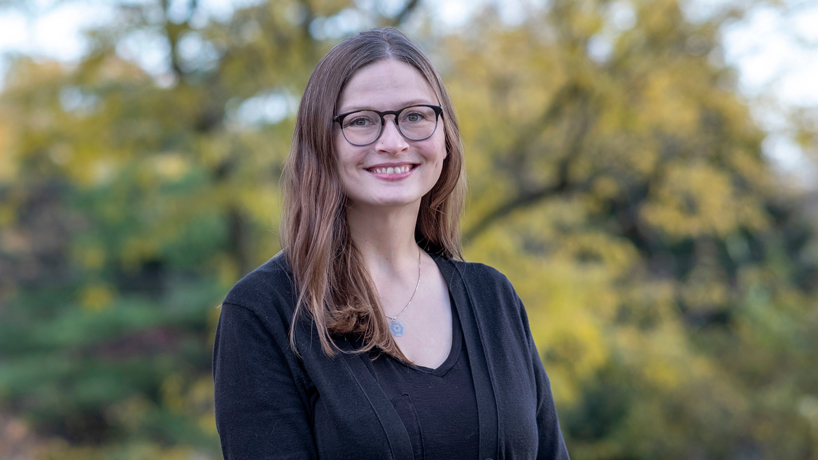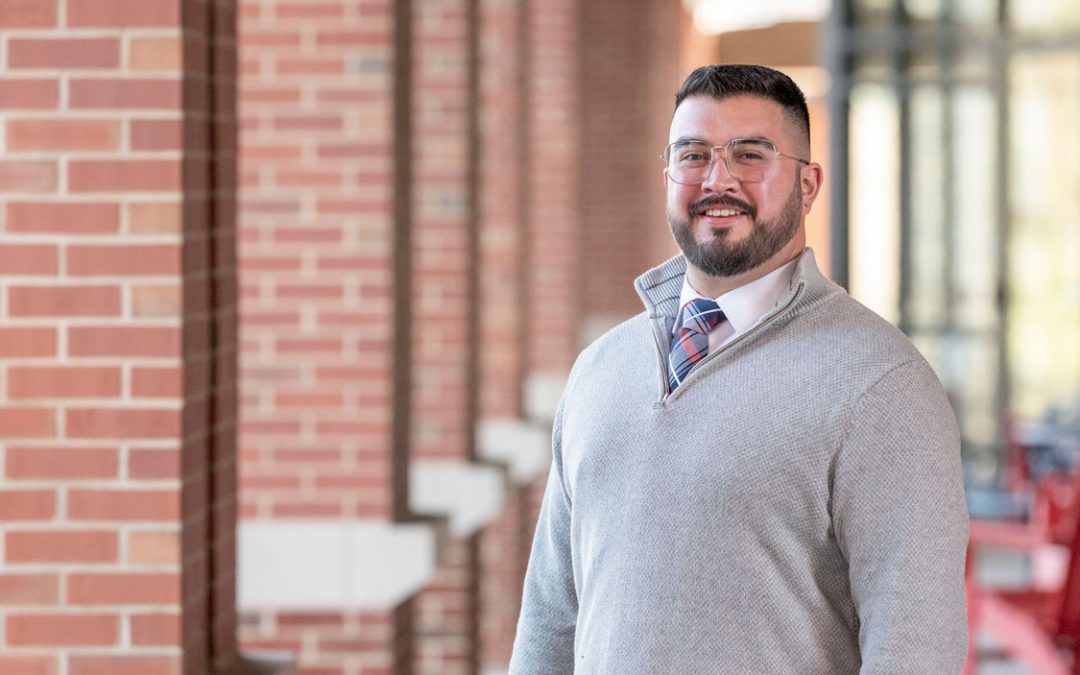
Eleanor Taylor, an education and English alumna, was one of seven finalists for the 2022 Missouri Teacher of the Year. Taylor has also taken opportunities to travel the globe, expanding her horizons and understanding of language education. She completed her student teaching in Fuxin, China, participated in the Japan Exchange and Teaching Program and traveled to Senegal to study the country’s education system as a Fulbright Teachers for Global Classrooms fellow. (Photo by August Jennewein)
The teenage girl sitting across from Eleanor Taylor was clearly frustrated. She had just immigrated to the United States, and Taylor was trying to gauge her English proficiency at Pattonville High School.
However, nothing seemed to overcome the language barrier. Eventually, the girl grabbed a piece of paper, scrawled on it quickly and shoved it at Taylor. The paper only contained two words in Spanish: No Inglés.
Taylor was undeterred, though. She would reach that student and help her learn English. By her senior year, the girl had become one of Taylor’s best students and was confident enough in her language skills to write and present an essay for the school’s Writers Week.
“Four years later, I got to sit in an auditorium full of her peers and watch this girl that four years ago had just written ‘No Inglés’ get up and read a multi-page essay in English about why she made this decision to come to the United States and how she was finally going to have the chance to go to college,” Taylor said.
It was one of Taylor’s proudest moments as an English learners teacher, and that unwavering dedication to her students has earned Taylor, a two-time graduate of the University of Missouri–St. Louis College of Education, recognition as one of Missouri’s top teachers.
This spring, the Pattonville School District named Taylor its Teacher of the Year. After winning the district-level award, she became one of 35 Regional Teachers of the Year. In September, the Missouri Department of Elementary and Secondary Education announced that she was one of seven finalists for the 2022 Missouri Teacher of the Year.
“Every time I made it to a new level in the process, there was, of course, excitement and pride, but also it was very humbling to think, out of all these incredible educators, I’m still the one being picked,” she said.
Throughout her career, Taylor has also taken opportunities to travel the globe, expanding her horizons and understanding of language education. She completed her student teaching in Fuxin, China, participated in the Japan Exchange and Teaching Program and traveled to Senegal to study the country’s education system as a Fulbright Teachers for Global Classrooms fellow.
Close to home
Taylor’s first experience with English learning was much closer to home.
Taylor’s grandmother emigrated from Japan to the United States and learned English later in life as an adult. While she achieved a conversational level of English, Taylor saw that she sometimes struggled with more technical aspects of the language.
“For most of her life, my grandfather helped her with things that required a lot of English,” Taylor said. “After he passed, she had to do things like go to the doctor by herself, go to the bank by herself, sign legal documents by herself. I realized the struggles that she was having in how to navigate some of those difficult tasks. That experience really showed me how proficiency in English equates to access to resources, to support and things in the community.”
But those experiences didn’t lead to an immediate calling to education or EL.
“I always knew I wanted to do some kind of social service work, some kind of public service work,” Taylor said. “I wanted to do something where I felt like my profession contributed to my community, but I wasn’t quite sure what that was.”
A new focus
In addition to service-based work, Taylor was interested in language and came to UMSL to study English. After earning her BA, she worked in the eldercare field for about a year as a recreational therapist at a skilled nursing facility.
The time working at the facility helped Taylor refocus her career path. She loved the work but wanted to use her English degree somehow. She also thought she could make a greater impact working with kids.
After her positive experience in the English program, Taylor decided on returning to UMSL to pursue her master’s in education. She noted that the College of Education did an excellent job providing necessary content knowledge and teaching skills but also creating opportunities for students to pursue specific educational interests.
In 2008, Taylor began working toward an MEd in secondary education and a high school English teaching certificate, but she knew she wanted an EL certificate, as well. The College of Education and UMSL Global offered a unique opportunity to pursue both goals.
“I did a study abroad program where I went to northeastern China, so I did my student teaching in Fuxin,” she said. “I had a student teaching assignment that was specifically working with language learners.”
After finishing her MEd in secondary education, Taylor stayed at UMSL to earn an additional MEd in elementary education.
Post-graduation, the Japan Exchange and Teaching Program offered Taylor a chance to gain more experience with English learners and to reconnect with her family history. The program places participants in Japanese schools to assist with foreign-language classes and to serve as cultural ambassadors. Taylor served as an assistant language teacher at Fukuoka Senior High School from 2012 to 2014.
“I went to Japan to teach English for two years, partly because I wanted the experience of being in a country where I wasn’t fluent in the primary language to see how that would help me better understand my students,” she said. “But I also wanted to improve my Japanese and get to know my Japanese family a little bit better.”
Upon returning from Japan, she began working at Pattonville High School as an EL teacher. The Pattonville School District was the perfect place to utilize her language education skills. It’s one of the most diverse school districts in the state, with more than 30 languages spoken in its schools.
Tools for success
There are still many misconceptions about EL programs and who EL students are. While many of Taylor’s students are recent immigrants and refugees, others don’t fit that description.
A significant portion of her students were born in the U.S. and speak English but are from families that don’t speak much English at home. With limited use at home, they’re not necessarily set up to have the same level of success in the classroom as some of their peers.
Taylor teaches “sheltered” classes comprised only of EL students that address the needs of both groups. For those just learning English, she works on the basics of the language and how to sufficiently express needs and wants. For those with English skills, she works on improving reading and writing skills so they have the tools to be successful academically.
EL students get support outside of sheltered classes, too. Taylor co-teaches several classes with EL and non-EL students, including history and level-two English, where she helps adapt assignments so EL students have equal access to support. She also carries a caseload – students she regularly meets with to measure their progress and offer guidance.
“The social, emotional element is a large part,” Taylor said. “We’re working with a lot of immigrant and refugee youth. Sometimes it is about normal teenage things, maybe feeling a little uncomfortable trying to find their place, trying to build a community. But, also, I work with a lot of students who have experienced trauma. I work with a lot of students who are going through culture shock. I work with a lot of students who still feel a strong tie to a community that is miles and miles away.”
Building community
The relationships Taylor developed with students from across the globe spurred her to apply for the 2018-2019 Fulbright Teachers for Global Classrooms Program, which includes professional development courses on global education, a symposium in Washington, D.C., and a short-term foreign exchange.
She chose to travel to Senegal in western Africa because many of her students are from the region, and it’s a country where only a small minority speaks French – the official language used in schools and government – as their primary language.
The fellowship exemplifies Taylor’s dedication to fostering understanding and building community – one that can be diverse, global and, most importantly, welcoming. It’s an idea she emphasizes every day in the classroom.
“In terms of a message, it’s that you matter,” she said. “The things you do matter. The choices you make matter. How we interact with each other matters. All of those things together build this community that we all share, and we all create together.”














